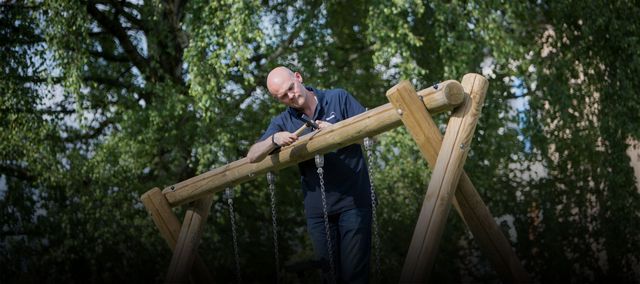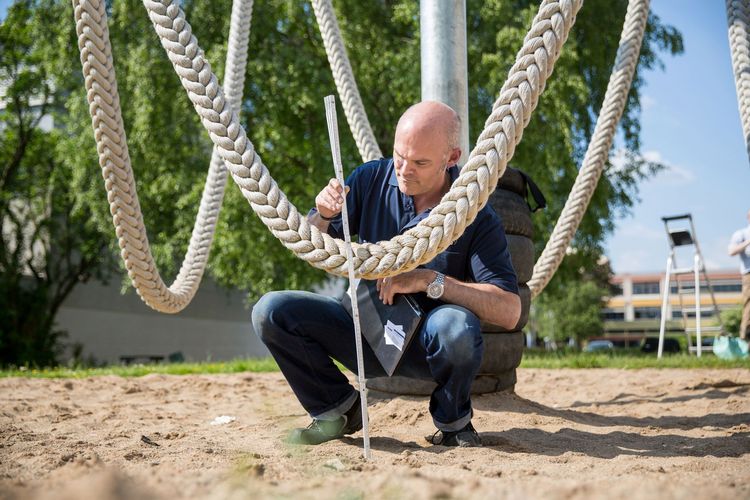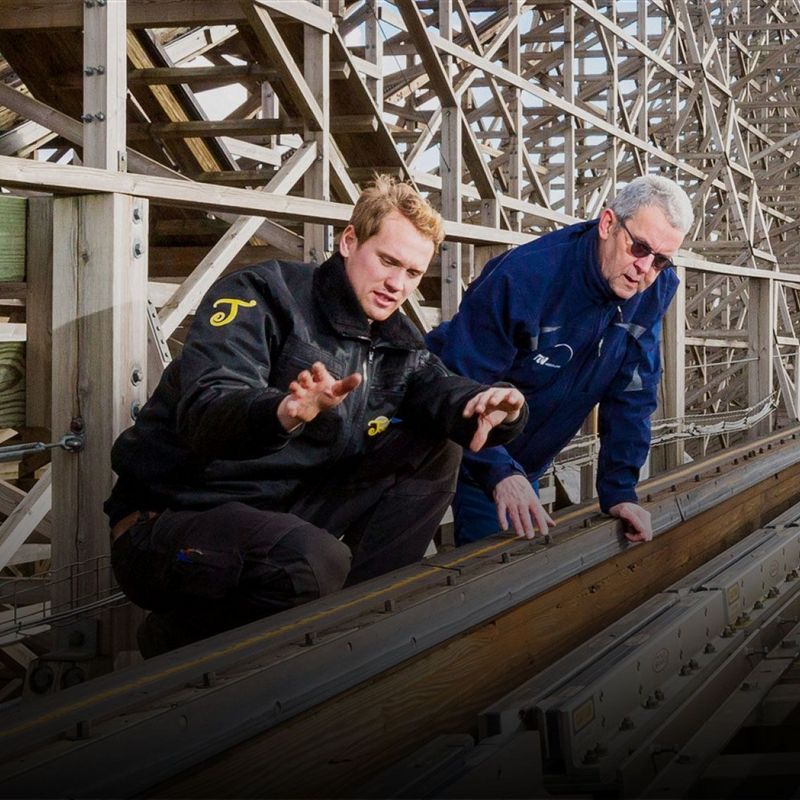8 September 2016
Operators of playgrounds must observe a whole raft of rules. Rainer de Vries know almost all of them by heart: for TÜV NORD he tests the safety of swings and slides. The expert detects vulnerabilities at a glance - and can even hear them.
Clunk clunk clunk. Rainer de Vries breaks into a frown and listens. Once again. He is standing on a ladder propped up against the swing frame, bashing the cross-beam with his hammer: clunk clunk clunk. The frown disappears, he smiles, everything is as it should be. Rainer de Vries can hear the difference between dry and rotten wood. “Bone-dry wood like this makes a nice noise. The sound of rotten wood is more muffled,” says de Vries, climbing down the ladder with the hammer in his hand.
© Franz BischofEvery centimetre counts: Rainer de Vries measures for compliance with all prescribed dimensions.© Franz BischofPlaygrounds aren’t just a place of work for Rainer de Vries; he often also frequents them with his eleven-year-old daughter.© Franz BischofWhat looks like a stainless steel bar is in fact a finger mock-up. Experts use it to check whether little hands can get caught in chains and windings.© Franz BischofDepending on the drop, there are regulations which determine exactly what surface material is to be used to offer the best possible protection in the event of a fall.
Rainer de Vries is a playground inspector at TÜV NORD and inspects slides, climbing walls and seesaws. This is because playground operators are obliged to ensure the safety of their equipment and premises; regular maintenance and inspection is therefore mandatory. Experts from TÜV NORD take responsibility for both initial acceptance testing and the annual inspection of playgrounds in schools, kindergartens and public facilities.
Rainer de Vries’ territory is the Hanover area. Today he is checking a playground on the school grounds of a small municipality, a few kilometres south-east of the state capital of Lower Saxony. Although the playground is a bit long in the tooth, the equipment is now being tested for the first time. “The operator hadn’t realised that it was responsible for safety here,” says de Vries. A state of affairs which is not uncommon. On the contrary: “Lots of operators don’t know that it’s they - and not the manufacturer, for instance – who are responsible for the playground.” What happens at least as often is that the documents for the playground are missing. The documents are supposed to provide information about the manufacturer, year of manufacture, material and correct method of installation. This time, too, the documents are missing.
“Lots of operators don’t know that they’re responsible for their playgrounds.”
Another weak point of many playgrounds is the wooden beams that support the swings. Rain, snow and frost attack the material in the winter. It can be difficult for the beam to dry, particularly when the swings are positioned in the shade or under trees. The wood rots and can no longer reliably bear the load. In such a case the beam has to be replaced immediately – at the risk of a ban on use. Fortunately, the swing on the playground which de Vries is checking today is out in the open. It makes a good impression, even at first glance; the “nice noise” generated by the hammer test confirms the verdict of de Vries’ experienced eye: No defects.
De Vries' main tool is the hammer. Just as indispensable is the “Bible”. This is what Rainer de Vries calls the “DIN-Taschenbuch 105 – Spielplätze und Freizeitanlagen” (“DIN pocket book 105 - playgrounds and leisure facilities”) - a 664-page strong reference book that meticulously lists all the dimensions and guidelines required by the European playground standard DIN EN 1176. For example, the permitted size of the grains of washed sand is dictated to the millimetre: 0.2 to 2 mm. Rainer de Vries knows many of the figures from the “Bible”. “In the case of drops of up to three metres, the fall protection, whether it be sand, wood chips or turf, must be 40 centimetres deep to provide protection from injury in the event of a fall,” quotes de Vries from the “Bible”. To check this out for the climbing net on the site he needs a small shovel, which looks more like a toy from a sandpit than a piece of working kit. Just two or three powerful thrusts into the ground, and Rainer de Vries has dug a small hole. Reaching for his rule, he takes the measurement: 40 centimetres with some slack below, that’s fine. He pushes the sand back into the hole with the shovel - “someone might otherwise stumble and hurt themselves.”
Hammer, shovel, rule - by no means all of Rainer de Vries’ equipment is as common as these three important tools. His DIY store tool kit, which is as big as three drinks crates, contains a number of red plastic objects that resemble kitchen bowls. It’s only the protruding handle that reveals that they can’t in fact be for mixing flour. De Vries reaches into the box and holds up a small form: “This is a German standard child’s body.” 22 centimetres wide, the average shoulder span of a small child. “Test pieces” are what the “Bible” calls them. Playground experts use them to detect possible points of entrapment. The distance between ladder rungs, for example, must not be large enough to allow the test piece to pass through. The other forms are labelled with smaller letters using a black marker. One of them is marked “small head”, the other “big head”. The toolbox also contains finger mock-ups, which look like thick metal pins. Rainer de Vries uses them to check every swing chain, winding and joint. The finger mock-up does not fit in any of them - meaning that there’s no chance of little hands becoming trapped when the child is on the swing.
On this occasion de Vries hardly finds any defects: the playground is in good condition. One of the tyres is porous, a small connector has broken off on the net swing, and the documents are missing. Defects that Rainer de Vries notes down on his clipboard with his purple pen. The operator is given the test report and is obliged to rectify the defects. Only then can the playground claim to be TÜV tested.
After one-and-a-half hours, Rainer de Vries finishes the inspection. Just a few more photos for the report and the archive, and he’s done. Today’s playground did not feature his favourite fixture, the high climbing pyramid. This he loves climbing with his eleven-year-old daughter - notwithstanding a fear of heights that he is trying to overcome. And yet, de Vries can’t simply switch off his tester’s eyes. "I also immediately scan every playground even when I'm not at work,” says de Vries, before adding that he doesn’t “tell on anyone”.
YOU MAY ALSO LIKE
ABOUT RAINER DE VRIES
© Franz Bischof
Rainer de Vries is a playground inspector at TÜV NORD and inspects slides, climbing walls and seesaws. This is because playground operators are obliged to ensure the safety of their equipment and premises; regular maintenance and inspection is therefore mandatory.












